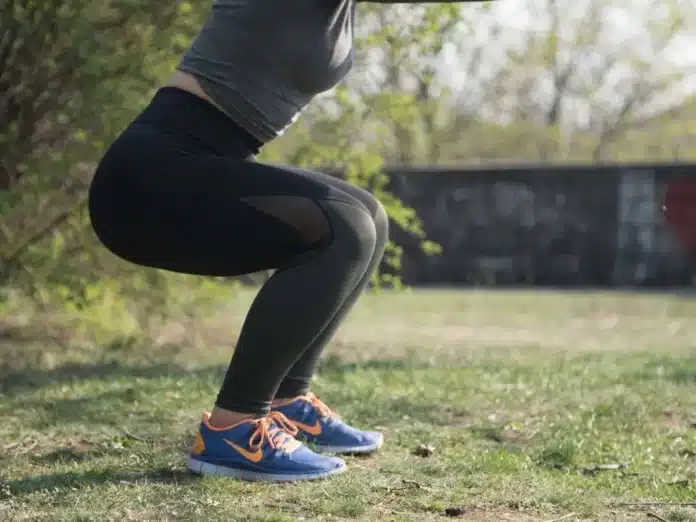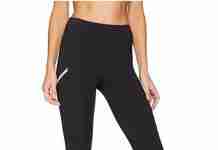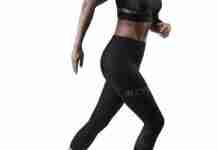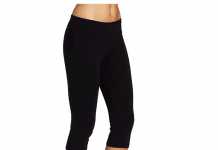Leggings have become a staple in our wardrobes, providing comfort and style. However, with so many options available, it can be challenging to determine which fabric is the most comfortable. Luckily, we have researched for you. In this article, we will explore the various fabric options for leggings and reveal the ultimate winner in the quest for the most comfortable fabric. Get ready to feel cozy and stylish in your leggings!
Review contents
Cotton
Benefits of cotton leggings
Cotton leggings are famous among many people due to their numerous benefits. One of the most significant advantages of cotton leggings is their breathability. Cotton is a natural fiber that allows air to circulate, keeping the body cool and preventing excessive sweating. This makes cotton leggings ideal for wearing in warm weather or during physical activities.
Another great benefit of cotton leggings is their softness. Cotton fibers are known for their smooth texture, providing a comfortable and cozy feel against the skin. The softness of cotton leggings makes them a favorite choice for loungewear and casual wear.
In addition to breathability and softness, cotton leggings are also moisture-wicking. Cotton can absorb moisture from the body, keeping the wearer dry and comfortable. This moisture-wicking property makes cotton leggings suitable for workouts or activities that may cause sweating.
Furthermore, cotton leggings offer exceptional comfort. The natural cotton fibers allow for a comfortable and non-restrictive fit, making them perfect for everyday wear. Whether running errands, walking, or simply lounging at home, cotton leggings will provide you with the desired comfort.
Lastly, cotton leggings are highly durable. The strength and resilience of cotton fibers make them long-lasting and capable of withstanding regular wear and tear. With proper care, cotton leggings can last significantly, making them cost-effective.
Drawbacks of cotton leggings
While cotton leggings have numerous advantages, it is also essential to consider their drawbacks. One of the main drawbacks of cotton leggings is their poor elasticity. Cotton fibers have limited stretchability, resulting in a less form-fitting and snug fit than leggings made from other fabrics.
Moreover, cotton leggings provide less support than those made from synthetic fabrics. This lack of support can concern individuals who require additional support for their muscles or joints, especially during intense workouts or activities.
Additionally, cotton leggings may not be suitable for intense workouts that involve excessive sweating. While cotton is moisture-wicking, it may not be as efficient at wicking away sweat as synthetic fabrics. This can lead to discomfort and a wet feeling during rigorous physical activities.
Overall, while cotton leggings offer benefits such as breathability, softness, moisture-wicking, comfort, and durability, their poor elasticity, less support, and potential discomfort during intense workouts may be a drawback for some individuals.
Polyester
Advantages of polyester leggings
Polyester leggings have become increasingly popular due to their unique properties. One of the significant advantages of polyester leggings is their stretchability. Polyester fibers have excellent elasticity, allowing the leggings to mold to the body and provide a snug and comfortable fit. This stretchability makes polyester leggings ideal for activities that require a wide range of movement, such as yoga or dancing.
Furthermore, polyester leggings are known for their moisture management capabilities. Polyester fibers have moisture-wicking properties, meaning they can draw moisture away from the body and towards the fabric’s surface, where it can evaporate. This helps keep the skin dry and comfortable during workouts or intense physical activities.
Another advantage of polyester leggings is their shape retention. Polyester fibers have a high level of resilience, meaning they can maintain their shape even after multiple washes or extended periods of wear. This ensures the leggings maintain fit and do not stretch out or become misshapen over time.
Additionally, polyester leggings are highly durable. Polyester fibers are resistant to shrinking, stretching, and wrinkles, making the leggings long-lasting and able to withstand regular wear and washing. This durability makes polyester leggings a practical and cost-effective choice.
Drawbacks of polyester leggings
While polyester leggings offer several advantages, they also have some drawbacks that must be considered. One of the main drawbacks of polyester leggings is their poor breathability. Polyester fibers do not allow air to pass through easily, resulting in limited airflow and potentially causing the body to feel hot and sweaty, especially in warm weather or intense workouts.
Moreover, polyester leggings are generally less soft than those made from natural fibers. The synthetic nature of polyester can result in a slightly rougher texture, which may not be as comfortable against the skin, especially for individuals with sensitive skin.
Another potential drawback of polyester leggings is their tendency to retain odor. Polyester fibers can absorb and hold onto odor molecules, resulting in unpleasant smells even after washing. This can concern individuals who engage in activities that cause perspiration, as the leggings may require more frequent washing or unique odor-removing treatments.
Additionally, polyester is not considered eco-friendly. The production of polyester involves the use of chemicals and energy, leading to a significant carbon footprint. Polyester leggings may not be the preferred choice for individuals who prioritize sustainability and environmental impact.
In conclusion, polyester leggings offer stretchability, moisture management, shape retention, and durability advantages. However, their poor breathability, less softness, potential odor retention, and lack of eco-friendliness may be considered drawbacks for some individuals.
Nylon
Benefits of nylon leggings
Nylon leggings are becoming increasingly popular due to their unique properties. One of the significant benefits of nylon leggings is their high strength and flexibility. Nylon fibers have exceptional tensile strength, making the leggings resistant to tearing or snagging. This ensures that the leggings remain intact even during rigorous activities or movements.
Additionally, nylon leggings are moisture-wicking. Nylon fibers can quickly absorb and evaporate moisture, keeping the wearer dry and comfortable. This makes nylon leggings ideal for activities that cause sweating or require quick-drying properties.
Furthermore, nylon leggings are lightweight. The lightweight nature of nylon fibers allows for easy movement and unrestricted mobility, making the leggings suitable for various physical activities.
Drawbacks of nylon leggings
Despite their benefits, nylon leggings also have some drawbacks that should be considered. One of the main drawbacks of nylon leggings is their lack of breathability. Nylon fibers do not allow air to circulate freely, resulting in limited airflow and potential discomfort in warm weather or during intense workouts.
Moreover, nylon leggings may not be as soft as leggings made from natural fibers. The synthetic nature of nylon can lead to a slightly rougher texture, which may not provide the same level of comfort as fabrics like cotton or bamboo.
Additionally, nylon is not considered to be an eco-friendly fabric. The production of nylon involves using chemicals and energy, contributing to environmental pollution and resource depletion. For individuals who prioritize sustainability and eco-conscious choices, nylon leggings may not be ideal.
Furthermore, nylon leggings may be prone to pilling, especially in high-friction areas. Pilling occurs when small balls of fibers form on the fabric surface, resulting in a less smooth and visually appealing appearance. This can concern individuals who prefer their leggings to look new and well-maintained.
In summary, nylon leggings offer high strength and flexibility, moisture-wicking properties, quick-drying capabilities, and a lightweight feel. However, their lack of breathability, less softness, limited eco-friendliness, and potential for pilling may be considered drawbacks for some individuals.
Spandex
Advantages of spandex leggings
Spandex leggings, also known as athletic or compression leggings, offer numerous advantages that make them popular for active wear. One of the critical advantages of spandex leggings is their excellent stretchability. Spandex fibers are known for their exceptional elasticity, allowing the leggings to stretch and conform to the body without losing shape. This stretchability provides a form-fitting and flattering fit that accentuates curves and allows for a wide range of movement.
Furthermore, spandex leggings are highly form-fitting. The snug and tight fit of spandex leggings provides compression and support to the muscles, enhancing performance and reducing muscle fatigue. This makes spandex leggings preferred for athletes and individuals engaged in high-intensity workouts.
In addition to stretchability and support, spandex leggings are ideal for active wear due to their enhanced breathability. Many spandex leggings are designed with mesh panels or moisture-wicking properties that allow for better air circulation and moisture evaporation, keeping the body cool and dry during workouts.
Lastly, spandex leggings are suitable for a variety of physical activities. Whether running, practicing yoga, weightlifting, or participating in any other form of exercise, spandex leggings offer the flexibility, support, and comfort needed for optimal performance.
Drawbacks of spandex leggings
While spandex leggings have numerous advantages, they also have some drawbacks that should be considered. One of the main drawbacks of spandex leggings is their lack of breathability. Although beneficial for compression and support, the tight fit of spandex leggings can limit airflow and result in a less breathable fabric. This can lead to a feeling of heat and discomfort, especially during intense workouts or in warm weather.
Moreover, spandex leggings may not be as soft as leggings made from natural fibers. The presence of spandex fibers can result in a slightly synthetic feel that may not be as comfortable against the skin, particularly for individuals with sensitive skin.
Another potential drawback of spandex leggings is the possibility of skin irritation. Some individuals may experience an allergic reaction or sensitivity to spandex fibers, leading to itching, rashes, or redness. It is essential to consider personal sensitivities before choosing spandex leggings.
Furthermore, while spandex leggings are durable, they may be less durable than those made from fabrics like cotton or nylon. The intense stretching and frequent washing that can occur with spandex leggings may cause the fibers to break down over time, resulting in a shorter lifespan.
In summary, spandex leggings offer advantages such as excellent stretchability, form-fitting support, enhanced breathability, and suitability for active wear. However, their lack of breathability, less softness, potential for skin irritation, and decreased durability compared to other fabrics may be drawbacks to consider.
Blend Fabrics
Cotton-spandex blend
A popular option among leggings is the cotton-spandex blend fabric. This fabric combines the benefits of both cotton and spandex to provide a versatile and comfortable legging option.
The advantages of a cotton-spandex blend fabric include a combination of properties from both cotton and spandex. The cotton fibers in the blend add breathability, softness, and moisture-wicking properties to the leggings. Cotton allows air to circulate, keeping the body cool, while its soft texture adds comfort. Additionally, cotton absorbs moisture, keeping the wearer dry during physical activities.
On the other hand, spandex fibers add stretchability and form-fitting support to the leggings. The cotton and spandex blend allows for a snug and flattering fit that moves with the body, making it ideal for various activities, including workouts.
However, there are potential drawbacks to consider with cotton-spandex blend leggings. The variability in quality among different brands and manufacturers can affect the overall performance and durability of the leggings. Choosing a blend that is well-made and high-quality is essential to ensure longevity and satisfaction.
Additionally, cotton-spandex blend leggings may be prone to pilling or fading, especially with frequent washing or use. Proper care and maintenance, such as washing them inside and avoiding harsh detergents, can help minimize these issues.
Overall, the cotton-spandex blend fabric combines the benefits of breathability, softness, moisture-wicking, and stretchability, making it a desirable option for comfortable and versatile leggings.
Polyester-spandex blend
Another popular choice for leggings is the polyester-spandex blend fabric. This blend offers the polyester and spandex fiber advantages, making it an excellent option for those seeking specific properties in their leggings.
The advantages of a polyester-spandex blend fabric include excellent stretchability, moisture management, and shape retention. The spandex fibers in the blend provide the leggings with the ability to stretch and conform to the body’s shape, ensuring a comfortable and form-fitting fit. Meanwhile, the polyester fibers contribute to moisture-wicking, drawing sweat away from the body and allowing it to evaporate quickly. The blend’s polyester content also helps the leggings maintain shape over time, preventing them from stretching out or sagging.
However, polyester-spandex blend leggings have potential drawbacks that should be considered. One of these drawbacks is poor breathability. While the moisture-wicking properties of polyester help keep the body dry, the fabric itself does not allow for significant airflow, potentially causing the body to feel hot and sweaty during intense activities or warmer weather.
Polyester-spandex blend leggings may also be less soft than those made from natural fibers. The synthetic nature of polyester can result in a slightly rougher texture, mainly if the fabric contains a higher percentage of polyester than spandex.
Furthermore, the odor retention potential of polyester fibers can be a concern for some individuals. Polyester can hold onto odors, even after washing, resulting in an unpleasant smell lingering on the leggings. Choosing a quality blend and following proper care instructions can help minimize this issue.
In conclusion, a polyester-spandex blend fabric provides stretchability, moisture management, and shape retention advantages. However, potential drawbacks include poor breathability, less softness, and potential odor retention.
Nylon-spandex blend
The nylon-spandex blend fabric combines the unique properties of nylon and spandex fibers, resulting in leggings that offer strength and stretchability.
The benefits of a nylon-spandex blend fabric include high strength, flexibility, moisture-wicking, and quick-drying properties. The nylon fibers in the blend provide excellent tensile strength, making the leggings resistant to tearing or snagging. This durability allows the leggings to withstand rigorous activities without compromising their integrity.
Additionally, nylon fibers have moisture-wicking capabilities, drawing sweat away from the body and allowing it to evaporate quickly. This keeps the wearer dry and comfortable during workouts. The quick-drying nature of nylon-spandex blend leggings is particularly beneficial for perspiration activities.
While nylon-spandex blend leggings have numerous advantages, there are also drawbacks. One of these drawbacks is the lack of breathability. The tight-knit nature of nylon-spandex blend fabric limits airflow, potentially causing the body to feel hot and sweaty during physical activities or warm weather.
Furthermore, the blend may be less soft than leggings made from natural fibers. Nylon fibers can introduce a slightly rougher texture to the fabric, which may not be as comfortable against the skin, especially for individuals with sensitive skin.
Additionally, nylon-spandex blend fabrics are generally less eco-friendly than natural fiber. The production of nylon involves using chemicals and energy, contributing to environmental pollution. Other fabric choices may be more suitable for individuals concerned about sustainability and reducing their carbon footprint.
Lastly, nylon-spandex blend leggings may be prone to pilling, particularly in areas of high friction or repetitive movement. Pilling occurs when small balls of fibers form on the fabric surface, resulting in a less smooth and visually appealing appearance. Care should be taken to minimize pilling, such as avoiding rough surfaces or combining the leggings with fabrics that are prone to causing friction.
In summary, nylon-spandex blend leggings offer high strength, flexibility, moisture-wicking, and quick-drying capabilities. However, their lack of breathability, less softness, limited eco-friendliness, and potential for pilling may be considered drawbacks for some individuals.
Modal
Benefits of modal leggings
Modal leggings are known for their silky-soft feel and numerous advantages. One of the main benefits of modal leggings is their luxurious feel against the skin. Modal fibers are derived from beech tree pulp, resulting in a smooth, soft, and highly comfortable fabric. The luxurious texture of modal leggings adds a touch of indulgence to any outfit or activity.
Another advantage of modal leggings is their breathability. Modal fibers have excellent moisture-wicking properties, allowing the leggings to draw moisture away from the body and allow it to evaporate quickly. This helps keep the wearer cool and dry during physical activities or warm weather.
Furthermore, modal leggings are resistant to shrinking. The fabric’s structure and properties make it less prone to shrinkage than other fabrics, ensuring that the leggings maintain their original fit and shape even after washing.
Additionally, modal fibers have exceptional color retention. This means modal leggings are less likely to fade or lose vibrancy, even after multiple washes. This makes them a durable choice that maintains its aesthetic appeal over time.
Drawbacks of modal leggings
Despite their benefits, modal leggings also have some drawbacks that should be considered. One of the main drawbacks of modal leggings is their less stretchability compared to other synthetic fabrics like polyester or spandex. While modal fibers have some natural elasticity, they may not offer the same level of stretch and form-fitting support as other fabrics, which can affect the overall fit and comfort of the leggings.
Moreover, modal leggings may be prone to fabric pilling. Pilling occurs when small balls of fibers form on the fabric surface due to friction or repeated use. While proper care and maintenance can help minimize pilling, it is essential to consider this potential issue when choosing modal leggings.
Additionally, modal leggings may be less durable than those made from other synthetic fabrics. Modal fibers have a lower breaking strength than fabrics like polyester or nylon. This means that modal leggings may be more prone to wear and tear, requiring frequent replacement or careful handling to maintain longevity.
Lastly, modal fibers are sensitive to heat. High temperatures, such as those encountered during hot water washing or drying, can damage the structure and properties of modal fabric, resulting in shrinkage or loss of softness. It is essential to follow the care instructions provided by the manufacturer to ensure the longevity and performance of modal leggings.
In conclusion, modal leggings offer a silky-soft feel, breathability, resistance to shrinking, and enhanced color retention. However, their less stretchability, potential for pilling, less durability compared to other synthetics, and sensitivity to heat may be drawbacks to consider.
Bamboo
Advantages of bamboo leggings
Bamboo leggings have gained popularity recently due to their unique properties and eco-friendly nature. One of the main advantages of bamboo leggings is the soft and luxurious feel of the fabric. Bamboo fibers are incredibly soft and gentle against the skin, creating a comfortable wearing experience. The softness of bamboo leggings makes them a desirable choice for individuals looking for a cozy and indulgent option.
Another advantage of bamboo leggings is their breathability and hypoallergenic properties. Bamboo fibers are naturally porous, allowing for better airflow and ventilation. This helps in regulating body temperature and preventing excessive sweating. Additionally, the hypoallergenic properties of bamboo make it suitable for individuals with sensitive skin or allergies, as it is less likely to cause irritation or allergic reactions.
Furthermore, bamboo leggings are known for their natural moisture-wicking properties. The bamboo fibers can absorb excess moisture from the skin and allow it to evaporate, keeping the wearer dry and comfortable. This makes bamboo leggings an excellent choice for workouts or activities that may cause perspiration.
Moreover, bamboo is considered to be an eco-friendly option. Bamboo is a highly sustainable plant that grows rapidly and requires less resources than other crops. The production of bamboo fabric also involves fewer chemicals and pollutants than traditional textile manufacturing. Bamboo leggings offer a more sustainable choice for individuals conscious of their environmental impact.
Drawbacks of bamboo leggings
While bamboo leggings have numerous advantages, they also have some drawbacks that should be considered. One of the main drawbacks of bamboo leggings is their lack of elasticity. Bamboo fibers have limited elasticity compared to fabrics like spandex or polyester. This can result in bamboo leggings being less form-fitting or offering less support than those made from other fabrics.
Additionally, bamboo clothing may require delicate care. Bamboo fibers’ soft and delicate nature means they may be more susceptible to damage if not correctly cared for. It is generally recommended to wash bamboo leggings on a gentle cycle and avoid using harsh detergents or fabric softeners to ensure their longevity.
Furthermore, bamboo fibers tend to shrink when exposed to high temperatures. Bamboo leggings may require special care during washing and drying to avoid shrinkage. Following the manufacturer’s instructions for care is essential to maintain the fit and integrity of the leggings.
Moreover, while bamboo offers various natural colors, the color choices for bamboo leggings may be limited compared to other fabrics. Many bamboo leggings come in earthy or neutral tones, which may not suit everyone’s preferences or outfit choices.
Bamboo leggings offer advantages such as a soft and luxurious feel, breathability and hypoallergenic properties, natural moisture-wicking, and eco-friendliness. However, their lack of elasticity, delicate care requirement, shrinkage potential, and limited color choices may be drawbacks for some individuals.
Fleece
Benefits of fleece leggings
Fleece leggings are highly valued for their exceptional warmth and cozy feel, making them perfect for colder weather or lounging at home. One of the main benefits of fleece leggings is their exceptional warmth. Fleece is a synthetic fabric known for its insulating properties, helping to trap and retain body heat. The warmth of fleece leggings makes them ideal for winter activities, outdoor adventures, or simply when you need an extra layer of coziness.
Moreover, fleece leggings are incredibly soft and cozy against the skin. The brushed surface of fleece creates a plush and velvety texture, providing a comfortable and relaxing wearing experience. The softness of fleece leggings adds an element of luxury and indulgence to any outfit or occasion.
Furthermore, fleece leggings offer insulation. The unique structure of fleece fabric assists in trapping air between the fibers, creating a layer of insulation that helps to keep the body warm. This insulation is particularly beneficial in cold climates or when engaging in winter sports.
Additionally, fleece leggings are moisture-wicking. Despite their warm and cozy nature, fleece fibers can wick away moisture from the body, keeping the skin dry and comfortable. This makes fleece leggings suitable for physical activities that may cause perspiration, as they help regulate body temperature and prevent excessive sweating.
Drawbacks of fleece leggings
While fleece leggings offer numerous benefits, they also have some drawbacks that should be considered. One of the main drawbacks of fleece leggings is their less breathability compared to other fabrics. The nature of fleece fabric, with its brushed surface and tightly knit fibers, limits airflow and can result in a less breathable garment. This may cause the body to feel hot and sweaty during intense activities or in warmer climates.
Moreover, fleece leggings can be bulky due to their insulation properties. The thick and lofty nature of fleece fabric can add volume, which may not be desirable for individuals seeking a slimming or streamlined fit. The bulkiness of fleece leggings can also make them less versatile or suitable for layering under specific clothing.
Furthermore, fleece leggings may offer less stretchability than leggings made from spandex or polyester fabrics. The insulation and thickness of fleece fiber can reduce the overall stretch and flexibility of the leggings, which may affect the range of movement or fit.
In summary, fleece leggings offer exceptional warmth, softness and coziness, insulation, and moisture-wicking properties. However, their less breathability, bulkiness, less stretchability, and limited versatility may be drawbacks for some individuals.
Microfiber
Advantages of microfiber leggings
Microfiber leggings offer a range of advantages that make them a popular choice for various activities and occasions. One of the main advantages of microfiber leggings is their ultra-soft and lightweight feel. Microfiber fibers are lovely and smooth, creating a luxurious, gentle texture against the skin. The lightweight nature of microfiber makes the leggings comfortable and barely noticeable, allowing unrestricted movement.
Additionally, microfiber leggings are breathable. Despite their softness and lightweight feel, microfiber fibers can allow air to circulate, preventing heat and moisture buildup. The breathability of microfiber leggings helps keep the body cool and dry, making them suitable for workouts or warm weather.
Furthermore, microfiber leggings offer excellent moisture-wicking properties. The fine fibers in microfiber fabric actively draw moisture away from the body and towards the outer layer of the leggings, where it can evaporate quickly. This keeps the wearer dry and comfortable during intense physical activities or situations that cause perspiration.
Moreover, microfiber leggings are highly durable. The tightly woven structure of microfiber fabric makes it resistant to tearing, pilling, or snagging, ensuring that the leggings maintain their appearance and performance even after extended periods of use. This durability makes microfiber leggings reliable for regular wear and frequent washing.
Drawbacks of microfiber leggings
While microfiber leggings offer numerous advantages, they also have some drawbacks that should be considered. One potential drawback of microfiber leggings is the possibility of static cling. Microfiber fibers can build up an electrical charge, resulting in static cling and potentially causing the leggings to stick to the body or attract lint or hair. Using anti-static products or adding a small amount of fabric softener during washing can help minimize static cling.
Moreover, microfiber leggings may offer less stretchability than leggings made from spandex or polyester fabrics. While microfiber fibers have some elasticity, they may not provide the same stretch and form-fitting support as other fabrics. This can affect the overall fit and comfort of the leggings, particularly for activities that require a wide range of movement.
Also, microfiber leggings may require delicate care to maintain softness and performance. The fine fibers of microfiber fabric can be damaged if not correctly handled. Following the manufacturer’s care instructions, such as avoiding high temperatures or harsh detergents, is crucial to ensure the longevity and quality of microfiber leggings.
Furthermore, microfiber leggings can be slippery. The smooth texture of microfiber fabric may reduce friction, causing the leggings to slide or shift during activities that involve a lot of movement. This can be uncomfortable or problematic for individuals seeking a more secure fit.
In summary, microfiber leggings offer ultra-soft and lightweight feel, breathability, moisture-wicking properties, and durability. However, their potential for static cling, less stretchability, delicate care requirements, and slippery nature may be drawbacks for some individuals.
Lycra
Benefits of lycra leggings
Lycra leggings, spandex, or elastane leggings provide numerous benefits that make them famous for various activities and styles. One of the main benefits of lycra leggings is their excellent elasticity. Lycra fibers are known for their exceptional stretchability and recovery. This means lycra leggings can stretch comfortably to accommodate the body’s shape without losing their original form. The elasticity of lycra leggings provides a snug and flattering fit that moves with the body and enhances flexibility.
Furthermore, lycra leggings offer shape retention. The durable nature of lycra fibers allows the leggings to maintain their shape even after multiple washes or extended periods of wear. This ensures that the leggings do not stretch out or become misshapen over time, maintaining their fit and performance.
Additionally, lycra leggings offer excellent comfort and support. The stretch and compression provided by lycra fibers create a supportive and contouring effect on the body. This support helps reduce muscle fatigue and aids in muscle recovery after workouts or intense physical activities. Lycra leggings are often preferred for athletes or individuals seeking additional support during workouts.
Moreover, lycra leggings are versatile. The stretch and flexibility of lycra fibers allow the leggings to adapt to various workout or fashion styles, making them suitable for a wide range of activities and occasions. Whether you are running, practicing yoga, or simply styling an outfit, lycra leggings offer the versatility needed for different situations.
Drawbacks of lycra leggings
Despite their benefits, lycra leggings also have some drawbacks that should be considered. One of the main drawbacks of lycra leggings is their poor breathability. Lycra fibers’ tight fit and stretchability can limit airflow, potentially causing the body to feel hot and sweaty during intense activities or in warmer climates.
Moreover, lycra leggings may offer less softness than those made from natural fibers like cotton or bamboo. The synthetic nature of lycra fibers can result in a slightly rougher texture against the skin, particularly for individuals with sensitive skin.
Another potential drawback of lycra leggings is the possibility of skin allergies. Some individuals may experience an allergic reaction or sensitivity to lycra fibers, resulting in itching, rashes, or redness. It is essential to consider personal sensitivities before choosing lycra leggings, particularly if you have a known sensitivity to synthetic fibers.
Furthermore, lycra fibers can potentially retain odors. The synthetic nature of lycra can allow the fabric to hold onto odor molecules, resulting in lingering smells even after washing. This can concern individuals who engage in activities that cause perspiration, as the leggings may require more frequent washing or unique odor-removing treatments.
In summary, lycra leggings offer excellent elasticity, shape retention, comfort, support, and versatility. However, their poor breathability, less softness, potential for skin allergies, and potential odor retention may be considered drawbacks for some individuals.



































